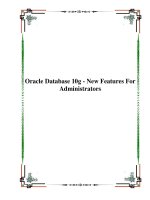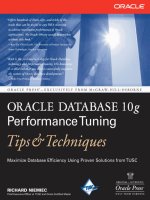oracle database 10g - proactive space & schema object management 2003
Bạn đang xem bản rút gọn của tài liệu. Xem và tải ngay bản đầy đủ của tài liệu tại đây (693.3 KB, 21 trang )
The Self-Managing Database:
Proactive Space & Schema
Object Management
An Oracle White Paper
Nov. 2003
The Self-Managing Database: Proactive Space &
Schema Object Management
Introduction 3
Proactive Tablespace Management 3
Overview 3
Tablespace Alerts 4
Special Tablespaces 6
Efficient, Real Time Tablespace Monitoring 7
Querying and Setting Thresholds using Enterprise Manager 8
Default User Tablespace 10
Segment Management 10
Create Table Estimator – how many disks would I need? 11
Growth Trend Report – how many more disks will I need for the
Christmas rush? 12
Segment Advisor – Can I reclaim some space? 13
Segment Shrink? – Let’s reclaim free space!! 14
Undo Management 16
Auto-sizing Undo Tablespace 16
Auto Tuning of Undo Retention 17
Undo Advisor 18
Proactive Undo Tablespace Monitoring 19
Fast Ramp-up 19
Guaranteed Availability of Undo 19
Conclusion 20
The Self-Managing Database: Proactive Space & Schema Object Management Page 2
The Self-Managing Database: Proactive Space &
Schema Object Management
INTRODUCTION
Space management is one of the most time consuming tasks for database
administrators. According to a survey conducted by Oracle, DBAs currently
spend approximately 20% of their time in performing space management
operations. Fortunately, the Oracle Database10g automatically manages its
space consumption, alerts administrators on potential space problems, and
recommends possible solutions. This paper details the solutions that enable
administrators to maintain optimal space distribution and, address space related
problems in an easy and timely manner. The paper covers the various
components of Tablespace Management, Segment Management and Undo
Management that make the Oracle Database 10g a self-managing database.
PROACTIVE TABLESPACE MANAGEMENT
Overview
The Proactive Tablespace Management (PTM) capability in the Oracle Database
10g brings efficient and powerful space monitoring, notification and space
trending to the Oracle Database. Prior to Oracle Database 10g, the tools
available for monitoring and setting up notifications regularly polled the
database to monitor its space usage. Querying space usage information requires
collecting data about the state of the database – state that is constantly changing
in a production system. Because such queries are inherently expensive, the
space monitoring tools typically run them infrequently, once a day or once every
couple of hours. When they are run, the queries steal CPU, IO and memory
(especially the buffer cache) resources away from critical business activity in the
production system. It’s a health check that is either late or hurts the health of the
system or worse, both!
With PTM, Oracle Database 10g introduces a non-intrusive and timely health
check of space in the database server. And best of all, PTM is available by
default, causes no measurable performance impact, and is uniformly available
across all tablespace types. Also, the same functionality is available both
through Enterprise Manager (EM) as well as SQL. PTM is available for use with
locally managed tablespaces. The health check is performed incrementally as
The Self-Managing Database: Proactive Space & Schema Object Management Page 3
space is allocated and freed up in the database server. This guarantees
immediate availability of space usage information whenever the user needs it. In
addition to computing it on-the-fly, space usage information is assembled
(across nodes in RAC) and alerts are pushed proactively every 10 minutes.
Fig 1: Viewing and Setting Alert Thresholds Using Enterprise Manager
Tablespace Alerts
The Oracle Database 10g provides the complete lifecycle around Tablespace
Alerts right into the database kernel Alert conditions are automatically
computed and a notification is sent to the administrator if required. Once the
underlying problem is fixed, any outstanding alerts are automatically cleared
and moved to alert history.
Alerts are pushed into the server side table that holds alerts (available through
DBA_OUTSTANDING_ALERTS) and are also made available through EM.
When an alert is cleared, it is archived in the alerts history table available
through DBA_ALERT_HISTORY.
Notification is performed using server generated alerts mechanism, which is yet
another new functionality in the Oracle Database 10g. The alerts are triggered
when certain space related events occur in the database. For example when the
space usage threshold of a tablespace is crossed, an alert is raised. Another
example of an alert is when a Resumable session encounters an out of space
situation. An alert is sent instantaneously to the DBA to take corrective
measures. The DBA may choose to get paged with the alert information and add
The Self-Managing Database: Proactive Space & Schema Object Management Page 4
space to the tablespace to allow the suspended operation to continue from where
it left off.
The database comes with a default set of alert thresholds. The DBA may
override the default for a given tablespace or set a new default for the entire
database through EM. The DBA may invoke the same functionality directly
using DBMS_SERVER_ALERT.SET_THRESHOLD procedure. Also, current
thresholds can be viewed using EM or through the
DBMS_SERVER_ALERT.GET_THRESHOLD procedure.
Fig 2: Tablespace threshold levels
Tablespace thresholds are defined in terms of the fullness of the tablespace as a
percentage. Critical and warning thresholds are two thresholds that apply to
tablespaces. The threshold values can be viewed and modified using Enterprise
Manager or the DBMS_SERVER_ALERTS package. When the tablespace
space utilization crosses either of these two limits, appropriate alerts are raised.
Conversely, when the space utilization falls below these thresholds, any
corresponding outstanding alert is cleared
The user can specify the critical or warning threshold values. If the user does not
specify a value, then a default of 85% and 97% are chosen for warning and
threshold values respectively. For databases migrating from previous releases,
the threshold values will be NULL – this indicates that tablespace threshold
alerts will not be raised until the DBA explicitly enables them. The database
wide default can be reset or modified when desired.
The Self-Managing Database: Proactive Space & Schema Object Management Page 5
Fig 3: Tablespace Alerts Displayed on Enterprise Manager Database Home Page
Special Tablespaces
Space in an Undo tablespace may be in one of four states:
• Not allocated to segments
• Allocated space being used by active transactions
• Allocated space being retained for queries and Flashback
• Allocated space not being retained
Allocated space being used by active transactions and the allocated space being
retained for queries/Flashback is considered as the “used space” for the purpose
of comparing it against the threshold. This is a key distinction from user
tablespaces.
For temporary tablespaces, “used space” is the space currently allocated to
sessions and being actively used. For temporary tablespace groups, thresholds
are set and evaluated on individual tablespaces.
For read-only and offline tablespaces, alerts are disabled.
For tablespaces with autoextensible files, the maximum tablespace size is
computed by the maximum file size declared in the create/alter statement.
The Self-Managing Database: Proactive Space & Schema Object Management Page 6
Efficient, Real Time Tablespace Monitoring
The key aspect of tablespace space monitoring is that the database server tracks
space utilization while performing regular space management operations, e.g.
allocating a new extent. When alert thresholds have been specified, every 10
minutes, a background process compares the state of the tablespaces against the
thresholds specified to determine if an alert should be raised or cleared. If a state
transition has occurred, the first instance (in a RAC environment) that detects
this triggers an appropriate action.
At the core of the alert infrastructure is the active space monitoring built into the
database server. Every instance in RAC maintains its own local information of
the state of various tablespaces. This information is aggregated every 10 minutes
to compute the global picture of the state of the database. In a non-RAC
environment this step is simply skipped. The aggregate information is
incrementally computed every 10 minutes to minimize the cost of this operation
– only data for tablespaces that have changed their space allocation profile is
considered. This is accomplished by using System Commit Numbers (SCNs) to
track changes to the state of a tablespace. It is important to note here that even
though the alert condition evaluation is done every 10 minutes, monitoring of
space is done in the real time whenever any space management operation is
performed. In other words, unlike external polling based management tools, the
Oracle Database 10g collects data about its space utilization simultaneously with
regular space management tasks and does not impose any additional overhead.
This also ensures that information is collected just in time and only if there is
any change in the database state as against an external tool which must query the
database periodically regardless of whether there is any activity or not.
These inter-node optimizations combined with a very lightweight
implementation of active space monitoring provide an efficient and scalable
technology to maintain accurate and up to the minute state of the system.
The Self-Managing Database: Proactive Space & Schema Object Management Page 7
Fig 4: Tablespace Space Threshold Evaluation
Querying and Setting Thresholds using Enterprise Manager
EM provides an easy but powerful set of UI to manage database thresholds.
Database wide defaults for the thresholds may be set from the Edit Metric
Thresholds page as seen in the graphic below. This page can be launched from
the database home page by selecting Edit Metric Thresholds under Related
Links. This link will allow users to set the threshold values for all tablespaces.
The Self-Managing Database: Proactive Space & Schema Object Management Page 8
Fig 5: Viewing and Modifying Default Database Level Thresholds using Enterprise Manager
Warning and Critical tablespace thresholds may also be set on a specific
tablespace directly from the Tablespaces page. To navigate to this page, start
from the Tablespaces page, then select the tablespace, then click Thresholds.
The Self-Managing Database: Proactive Space & Schema Object Management Page 9
Fig 6: Viewing and Modifying Thresholds for A Given Tablespace
Default User Tablespace
Oracle Database 10g also provides the ability to define a given tablespace as the
default user tablespace. When objects are created without the tablespace clause,
they are automatically placed in the default permanent tablespace (not in
SYSTEM tablespace, as previously). This simplifies manageability by making
sure that objects don’t get accidentally created in the SYSTEM tablespace. This
feature is similar to the default temporary tablespace functionality introduced in
Oracle9i.
SEGMENT MANAGEMENT
DBAs face a lot of challenges in managing space allocated to segments. Space
may get over-allocated because of the difficulty to predict the space requirement
of an object or because of the inability to predict the growth trend of an object.
On tables that are heavily updated, the resulting segment may have a lot of
internal fragmentation and maybe even row chaining. These issues may result in
a wide variety of problem symptoms in the database, from poor performance to
space wastage. This section describes the new functionality introduced in the
Oracle Database 10g to address these challenges.
The Self-Managing Database: Proactive Space & Schema Object Management Page 10
Create Table Estimator – how many disks would I need?
The Oracle Database 10g can predict the size of a given table based on its
stricture and estimated number of rows. This is a enables “what if” analysis that
allows estimation of the size of an object before it is created or rebuilt. If
tablespaces have different extent management policies then the tool will help
decide the tablespace that will cause least internal fragmentation. The Object
Space Advisor works for tables with indexes on them as well as Index
Organized Tables. The inputs to the cost estimator can be
Average row length, number of rows, PCTFREE, tablespace OR
Column description (data type, size), number of rows, PCTFREE, tablespace
PCTFREE is optional.
This functionality can be used either through EM or command line interface. In
Enterprise Manager, a new “Estimate Size” option is available while creating
new tables or indexes. The same operation can be performed from command line
using the DBMS_SPACE package.
Fig 7: Estimating the size of a table before its creation
The computation of the estimated size takes into account all the internal
structures that occupy space. For example, bitmap blocks, extent map blocks,
index branch blocks (in case of Index Organized Tables) are accounted in the
The Self-Managing Database: Proactive Space & Schema Object Management Page 11
space estimate. Oracle takes care of the internal metadata overhead to give the
user the correct answer.
By predicting the size of schema objects even before they have been created, the
Oracle Database 10g helps administrator plan up front and avoid any capacity
issues subsequently.
Growth Trend Report – how many more disks will I need for the
Christmas rush?
The growth trend report takes the DBA to the next step of capacity planning –
planning for growth. Most database systems grow over time. Planning for
growth is an important aspect of provisioning resources. If the DBA plans for
growth well in advance, out of space conditions can be avoided from occurring.
Of course, if and when they do occur, the Tablespace Alerts will provide you
with an early warning of the impending problem. At that time the user may want
to identify what objects are growing and predict the space utilization of the
future.
At the heart of both, the growth trend reporting as well as the Segment Advisor
(described later), is a built in mechanism to incrementally track space utilization
in every segment in the database. This is done incrementally and with a high
performance, low impact design along the lines of active space monitoring for
Tablespace Alerts as described previously. The active space monitoring of
individual segments in the database makes available to the database, the up to
the minute status of individual segments in the system. This information is
periodically written to the automatic workload repository. This provides
sufficient information over time to perform growth trending of individual
objects in the database as well as the database as a whole. The graphic below
shows the EM page that shows the graphical representation of table
“COUNTRIES” in the schema “HR”.
The Self-Managing Database: Proactive Space & Schema Object Management Page 12
Fig 8: Viewing object growth trend
The Growth Trend Report comprises of two components: 1. Growth history 2.
Growth forecast. Growth history is simply an interpolation of space usage data
collected by the database server on a continuous basis. The Growth forecast is
computed using straight-line projection. The slope of the line is determined
using linear regression (LR). LR determines the slope of the line that best fits
the data points. The slope is determined by finding the line that minimizes the
sum of squares of the vertical distance of the data points. This technique will
cause the spikes to be eliminated.
Segment Advisor – Can I reclaim some space?
The Oracle Database 10g introduces the ability to reclaim space from a segment
by shrinking it. Shrinking of a segment will make unused space available to
other segments in the tablespace and may improve the performance of queries
and DML operations. To go with Segment Shrink, is the Segment Advisor. The
Segment Advisor analyzes the specified tablespace or a schema for objects that
may be candidates for shrinking.
The Segment Advisor performs growth trend analysis on individual objects to
determine if there will be any additional space left in the object in 7 days. It then
uses the reclaim space target to select candidate objects to shrink. The Segment
Advisor can be invoked in the comprehensive mode. In this mode, in addition to
using the pre-computed statistics in the workload repository, the Segment
Advisor performs sampling of the objects under consideration to refine the
statistics for the objects. Although this operation is more resource intensive, it
may be used to perform a more accurate analysis, when desired.
The Self-Managing Database: Proactive Space & Schema Object Management Page 13
In the Enterprise Manager, the Segment Advisor may be navigated to from one
of three locations: from the tablespace page by selecting the Segment Advisor
menu item, Schema Object page by selecting the Segment Advisor menu item or
from the Advisor Central. The Segment Advisor may also be scheduled to run
at certain time (like a batch window) or even created as a repeating task (to be
run once a week on the OLTP tablespace, for example).
The analysis may also be limited to run within a certain interval. The Segment
Advisor returns within the time limited limit. The recommendation from the
Segment Advisor can be retained in the system for a specified period of time.
Segment Shrink? – Let’s reclaim free space!!
The Oracle Database 10g provides the ability to perform an in place
reorganization of data for optimal space utilization by shrinking it. As the name
suggests, it also provides the ability to both compact the space used in a segment
and then deallocate it from the segment. The deallocated space is returned to
the tablespace and is available to other objects in the tablespace. Sparsely
populated tables may cause a performance problem for full table scans. By
performing shrink, data in the table is compacted and the high water mark of the
segment is pushed down. This makes full table scans read less blocks and hence,
run faster. Also, during compaction, row chaining is eliminated whenever
possible.
Segment Shrink is an online operation – the table being shrunk is open to
queries and DML while the segment is being shrunk. Additionally, segment
shrink is performed in place. This is a key advantage over performing Online
Table Redefinition for compaction and reclaiming space. The DBA may
schedule segment shrink for one or all the objects in the database as nightly jobs
without requiring any additional space to be provided to the database.
Segment Shrink works on heaps, IOTs, LOBs, Materialized Views and Indexes
with row movement enabled in tablespaces with Automatic Segment Space
Management. When Segment Shrink is performed on tables with indexes on
them, the indexes are automatically maintained when rows are moved around for
compaction. User defined triggers are not fired, however, because compaction is
a purely physical operation and does not impact the application. Note that
Segment Shrink can be performed only on tables with row movement enabled.
Only applications that explicitly track rowids of objects will not be able to be
shrunk because the application tracks the physical location of rows in the
objects.
The Self-Managing Database: Proactive Space & Schema Object Management Page 14
Fig 9: How Can I Shrink Segments?
As shown above, the alter table/index/… syntax is modified to contain the
additional SHRINK SPACE [CASCADE] [COMPACT]. When the alter
command is invoked without COMPACT, the default behavior of the Shrink
command is to both perform the compaction and release the excess space back
to the tablespace. When the command is invoked with the COMPACT option,
only the compaction phase is performed. At the end of this phase the data has
been moved to the beginning section of the segment, but the excess space has
not been deallocated. The state of the the segment is remembered persistently.
When an ALTER TABLE/INDEX/… SHRINK SPACE follows this operation,
the database detects the fact that space has already been compacted and skips
this phase (with the exception of concurrent DML activity that may fragment the
segment after the compaction). Also, if the user interrupts the COMPACT
operation, whatever compaction has been performed so far is saved in the
database. The next invocation of COMPACT will pick up from where it left off.
Thus Segment Shrink is a restartable operation.
Enterprise Manager fully supports the shrink functionality. Using EM, one can
shrink a segment either as a response to Segment Advisor recommendation or
directly by selecting a table or index.
The Self-Managing Database: Proactive Space & Schema Object Management Page 15
Fig 10: Initiating a Segment Shrink using Enterprise Manager
UNDO MANAGEMENT
A lot of new enhancements to undo management make it easier to use than ever.
The enhancements are based on a self-learning system that can automatically
size an undo tablespace, dynamically tune undo retention, and provide fast
ramp-up during sudden bursts of activity. This section covers key features in this
area – Auto-tuning of undo retention, Auto-sizing Undo Tablespace, Undo
Advisor, Proactive Undo Tablespace Monitoring and Alerts, Fast Ramp-up and
Guaranteed Undo Retention
Auto-sizing Undo Tablespace
DBAs are often confronted with the task of selecting the correct size for a given
tablespace. The Oracle Database 10g brings a welcome relief by introducing a
number of easy to use capacity planning tools. As described above, the Create
Table Estimator provided estimates on the sizing requirements of application
data. The Oracle Database 10g provides similar help in sizing Undo tablespaces.
There are two ways of doing it. You could either size a system using the Undo
Advisor. It provides guidance on sizing undo tablespaces for the desired undo
retention. Or you could leave the system to automatically size the undo
tablespace by simply running the workload.
In the Oracle Database 10g, a DBA can provide one or more autoextensible files
to the undo tablespace and the database server will automatically grow the files
to the size required by the application. While this ability to auto extend a file has
The Self-Managing Database: Proactive Space & Schema Object Management Page 16
been available for a while now, in Oracle Database 10g, a self-learning system
is built into undo management. When you run your application against the
Oracle Database 10g, the system automatically learns how long the application
requires the undo data to be retained, either for read consistency or flashback
usage. This, in turn, is used to control how big the undo tablespace should grow.
This makes the Automatic Undo Management functionality fully self-contained
– as long as sufficient disk space is provided to the tablespace, the self learning
system automatically manages the undo tablespace.
The self-learning system also reacts to changing application needs – it is
constantly learning the application running on the database. For example, if
during daytime, a payroll system is running short transactions that last less than
10 minutes, the undo tablespace will grow to accommodate for the OLTP
activity. Then, during off peak hours, the OLTP activity dies down and long
running queries are run for payroll reporting purposes. This requires
undo_retention of a high value. The self-learning system automatically detects
the change in the DML activity and the change in the duration of the application
queries and adapts the undo tablespace to this new environment. Note that in the
absence of the self-learning system, if undo_retention was set to 10 minutes, the
report generation queries will fail. If undo_retention is set to be longer, then that
will cause excessive undo to be retained (and require more disk space) during
the OLTP workload. The self-learning system automatically adjusts
undo_retention to changing workload to adjust the resource configuration and
usage for efficient execution of the application.
Auto Tuning of Undo Retention
As described above, in Oracle Database 10g, undo_retention need not be
manually specified any longer. The self- learning component of undo
management learns the required undo retention from the workload running on
the database and dynamically adapts the undo_retention to that workload. If the
DBA does specify a value for undo_retention, then the self-learning component
still tunes the undo_retention, but does not allow it to fall below the user
supplied undo_retention. Undo_retention may be supplied, for example, when
using Flashback features. Because the system does not tune undo_retention
below the user supplied value, Flashback is available at least for that amount of
time.
There are two components to auto tuning undo_retention:
• Proactive Tuning. Undo retention is tuned to remain ahead of the
longest running query in the system. Query duration information is
collected every 30 seconds.
• Reactive Tuning. Undo retention is gradually lowered when the system
is running under space pressure – that is the system does not have
sufficient disk space available (if autoextensible files are present, they
The Self-Managing Database: Proactive Space & Schema Object Management Page 17
cannot be extended further) to accommodate the undo_retention for the
given undo generation rate of the system.
Auto tuning undo_retention allows for efficient use of the space in the
undo_tablespace by dynamically adapting to the workload. In addition, it
simplifies the job of a database administrator significantly by freeing them for
having to determine and set the proper value of undo retention manually.
Undo Advisor
The Oracle Database 10g includes the Undo advisor to help DBAs optimize the
undo configuration. It can provide answer to commonly asked questions such as:
• Is the size of my undo tablespace adequate for the application
workload?
• If I wish to set the undo retention to a given value, how big an undo
tablespace do I need?
• Given the size of my current undo tablespace, what is the maximum
undo retention database can support?
At the heart of the undo advisor is the continuous statistics gathering in the
database. The Oracle Database 10g continuously gathers statistics on the health
of the undo tablespace and stores it in the workload repository. These historical
statistics are then used to compute the space requirement if the undo retention
were to be changed or vice versa.
Fig 11: The Undo Advisor
The Self-Managing Database: Proactive Space & Schema Object Management Page 18
Proactive Undo Tablespace Monitoring
As described in the Tablespace Alert section, the database actively monitors
space usage in the undo tablespace. If the space usage crosses the warning or
critical thresholds, alerts are raised or cleared as the case may be.
Undo tablespaces may also trigger the Long Query Warning Alert – this alert
alerts the DBA of long running queries that may fail because the system may be
running low on free space in the undo tablespace.
Fast Ramp-up
The self-learning system that controls auto undo tuning preserves it’s learning
across instance shutdown. Through the workload repository, it keeps track of the
appropriate resource configuration that the system needs for optimal
performance. So instead of having to tune the system up and then quiesce down
during low activity, the self-learning system keeps the system in a state of
readiness. This enables the system to provide high performance and low
response time when the application load suddenly spikes up.
Guaranteed Availability of Undo
While using Automatic Undo Management, transactions take precedence over
queries in space consumption by default. For example, booking a sales order is
more important than querying the current sales results. There are times when the
success of queries is critical to the administrator as well as the application. For
example, generating reports for printing paychecks may be a critical operation
towards the end of a pay period in a HRMS system. Also, the DBA may choose
the use the Flashback features as an insurance to recover from
application/human errors. And this insurance may be critical part of the failure
recovery strategy. In such an environment, the DBA may wish to guarantee the
availability of undo in the undo tablespace for the specified undo_retention
duration.
The Oracle Database 10g allows the administrator to choose between the default
behavior of compromising the undo retention during space pressure or enforcing
a given undo retention. It may be noted that if the system does run into space
pressure, DML activity may get out of space errors in order to satisfy the
guarantee commitment. Of course, Undo Tablespace Alerts will fire long before
the system runs into space pressure.
The Self-Managing Database: Proactive Space & Schema Object Management Page 19
Fig 12: Guaranteeing Undo Retention
CONCLUSION
Space Management functionality in the Oracle Database 10g is a key contributor
in making it a self-managing database. It is designed to have self-awareness and
self-learning built into the core database engine. That, combined with intuitive,
integrated, uniform and easy to use Enterprise Manager user interface, makes
the task of space management in the Oracle Database 10g, significantly easier
and more powerful than ever.
The Self-Managing Database: Proactive Space & Schema Object Management Page 20
White Paper Title: The Self-Managing Database: Proactive Space & Schema Object Management
Nov 2003
Author:Amit Ganesh
Contributing Authors: Sushil Kumar
Oracle Corporation
World Headquarters
500 Oracle Parkway
Redwood Shores, CA 94065
U.S.A.
Worldwide Inquiries:
Phone: +1.650.506.7000
Fax: +1.650.506.7200
www.oracle.com
Oracle Corporation provides the software
that powers the internet.
Oracle is a registered trademark of Oracle Corporation. Various
product and service names referenced herein may be trademarks
of Oracle Corporation. All other product and service names
mentioned may be trademarks of their respective owners.
Copyright © 2002 Oracle Corporation
All rights reserved.









